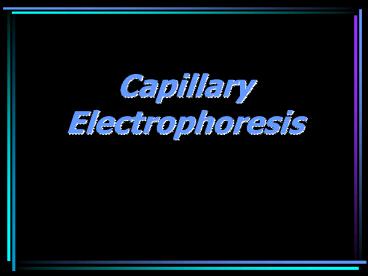Capillary Electrophoresis - PowerPoint PPT Presentation
1 / 20
Title:
Capillary Electrophoresis
Description:
... of components of a mixture using an electric field. v=Eq/f. v = velocity of ... The movement of ions solely due to the electric field, potential difference ... – PowerPoint PPT presentation
Number of Views:2047
Avg rating:3.0/5.0
Title: Capillary Electrophoresis
1
Capillary Electrophoresis
2
ElectrophoresisAn Overview
- Definition The differential movement for
migration of ions by attraction or repulsion in
an electric field. - Separation of components of a mixture using an
electric field - vEq/f
- v velocity of molecule
- E electric field
- q net charge of molecule
- f friction coefficient
3
Electrophoresis- overview cont.
- Can determine the size, shape, and charge of a
molecule - Different forms of electrophoresis are used for
each of these factors independently or in
combination.
4
Types of Electrophoresis
- Capillary
- Native Polyacrylimide Gel Electrophoresis (PAGE)
- SDS-PAGE
- Slab
- Paper
5
Capillary Electrophoresis Apparatus
6
Capillary Electrophoresis The Basics
- Electrophoresis in a buffer filled, narrow-bore
capillaries - Each capillary is about 25-100 µm in internal
diameter - When a voltage is applied to the solution, the
molecules move through the solution towards the
electrode of opposite charge - Depending on the charge, the molecules move
through at different speeds - Separation is achieved
7
Basics cont.
- A photocathode is then used to measure the
absorbencies of the molecules as they pass
through the solution - The absorbencies are analyzed by a computer and
they are represented graphically
8
(No Transcript)
9
Electrophoretic Mobility
- The movement of ions solely due to the electric
field, potential difference - Cations migrate toward cathode
- Anions migrate toward anode
- Neutral molecules do not favor either
10
Electrophoretic Mobility
- vEq/f
- vep µepE
- µ q/(6p?r)
- ? is buffer viscosity
- r is solute radius
- Properties that effect mobility
- Voltage applied
- Size and charge of the solute
- Viscosity of the buffer
11
Electroosmotic Flow
- As the buffer sweeps toward the anode due to the
electric field, osmotic flow dictates the
direction and magnitude of solute ion flow within
the buffer - All ions are then swept toward the anode.
- Negative ions will lead the neutral ions toward
the anode - Positive ions will trail the neutral ions as the
cathode pulls them
12
Electroosmotic Mobility
- veof µeofE
- µeof ?? / (4p?)
- ? buffer dielectric constant
- ? zeta potential
- Zeta Potential
- The change in potential across a double layer
- Proportional to the charge on the capillary walls
and to the thickness of the double layer. - Both pH and ion strength affect the mobility
13
Total Mobility
- vtot vep veof
- Migration times
- vtot l/t
- l distance between injection and detection
- t migration time to travel distance l
- t lL/((µep µeof)V
- L length of capillary
- V voltage
14
Ooooo! It MOVES
15
Equipment
- Capillary tube
- Varied length but normally 25-50 cm
- Small bore and thickness of the silica play a
role - Using a smaller internal diameter and thicker
walls help prevent Joule Heating, heating due to
voltage
16
Equipment
- Because ions are in the bulk solution are about
to travel through the capillary without
interference from the capillary itself, there is
no dramatic drop in potential within the
capillary - No meniscus is made
17
Equipment
Yowzah!!!
- Detector
- UV/Visible absorption
- Fluorescence
- Radiometric (for radioactive substances)
- Mass Spec.
18
Applications
- Analysis of carbohydrates
- Analysis of inorganic anions/metal ions
- DNA profiling
- Protein identification
- Advantages
- Fast
- Small Sample
- Relatively inexpensive
- Automated
- Disadvantages
- Cannot identify neutral species
- Joule Heating
- Cannot discern shape
19
Resources
- Altria, Kevin. http//www.ceandcec.com
- Hardy, James K. University of Akron.
http//ull.chemistry.uakron.edu/chemsep/electropho
resis/ - University of Virginia Chemistry Web page.
http//www.virginia.edu/chem/people/ - http//www.rsc.org/pdf/books/capelectrosc.pdf
- Landers, James. Electrophoresis SDS-PAGE.
http//toolkit.itc.virginia.edu/cgi-local/tk/UVa_C
LAS_2002_Fall_CHEM451-2/displaymaterialsLect5-SDS
-PAGE.ppt/SESSION10480818522765085466263962826/L
ect5-SDS-PAGE.ppt
20
ITS TIME TO PARTY!!!































